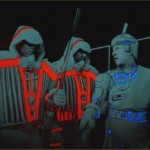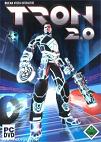 written by David Steffen
written by David Steffen
And now for a Bygone Game Review, a new label I made up to avoid getting complaints about the age of the review material. Yes, I know this isn’t a new game, but it has aged well, and is still well worth playing.
In 2003, twenty-one years after the release of the Tron movie, Buena Vista Entertainment released a sequel. It’s not a movie–it’s a game, a first person shooter (FPS) to be exact). The game somehow seems to have slipped under many gamers’ radars. I hadn’t come across it until five years after its release. Fans of the original movie will enjoy the digital world setting, reminiscent of the original in many ways yet also new and shiny, like 20 years of system upgrades in one fell swoop, and there are plenty of nods to the original for the dedicated fan to catch. But playing the game does not require familiarity with the original movie, so it could draw in new fans of the Tron universe, just in time for the long-awaited of the Tron movie sequel due out next month: Tron Legacy.
Story
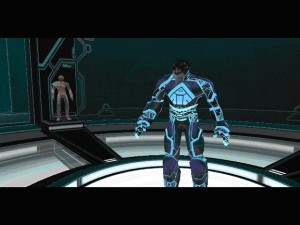 In the game setting, just like in real life, twenty-one years have passed since the events of the Tron movie. ENCOM has since been taken over by Future Control Industries (fCon). Alan Bradley (still voiced by Bruce Boxleitner) still works for the company. After the events of the original story, he married his then-girlfriend Lora, and together they had a son named Jet. Lora has died by the time of this game, and Alan has talked Jet into hiring on to fCon as a video game developer. Even though Lora is dead, actress Cindy Morgan still has a voice acting part, lending her voice to the program Ma3a.
In the game setting, just like in real life, twenty-one years have passed since the events of the Tron movie. ENCOM has since been taken over by Future Control Industries (fCon). Alan Bradley (still voiced by Bruce Boxleitner) still works for the company. After the events of the original story, he married his then-girlfriend Lora, and together they had a son named Jet. Lora has died by the time of this game, and Alan has talked Jet into hiring on to fCon as a video game developer. Even though Lora is dead, actress Cindy Morgan still has a voice acting part, lending her voice to the program Ma3a.
The game starts off when Jet gets digitized by the same invention that had digitized Flynn in the movie. Really, guys, don’t you think it’s time to create some safety features for that thing? But then, I suppose, we wouldn’t have any more Tron stories, and that would be sad, so never mind. At this point in the game, Jet is unaware of the laser or any of the events of the movie, so this is all new to him. He is greeted by the program Ma3a , Alan’s computer system’s AI, who has chosen to digitize him to fight the corruption caused by Thorne, a virus that is running rampant in the company network. She refers to Jet as Alan 2, not understanding the difference between program versions and human generations, which is a cute touch.
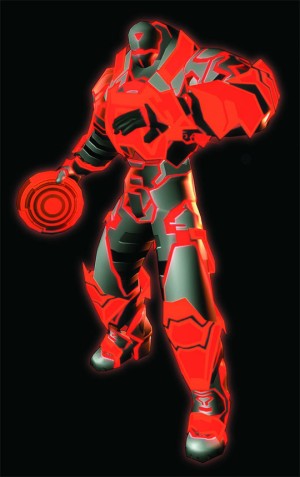 Meanwhile, the Kernel, the leader of the ICP security programs, detects Jet’s intrusion into the system and incorrectly determines him to be the source of the corruption. So Jet is opposed by not only the virus-corrupted programs he comes across, but also by the ICP’s as he tries to make his way across the virtual world to stop the corruption. As he goes, a larger and more sinister plot reveals itself which I will leave for you to discover. It’s a good story to accompany a great game, well worth the time.
Meanwhile, the Kernel, the leader of the ICP security programs, detects Jet’s intrusion into the system and incorrectly determines him to be the source of the corruption. So Jet is opposed by not only the virus-corrupted programs he comes across, but also by the ICP’s as he tries to make his way across the virtual world to stop the corruption. As he goes, a larger and more sinister plot reveals itself which I will leave for you to discover. It’s a good story to accompany a great game, well worth the time.
The Visuals
Wow is this game pretty! They perfected a really neat glowing light effect for this game so all the lighting has a bit of aura to give it a very neon look. The upgraded ICPs look awesome. The settings are very simplistically designed and are often just black with neon highlights, but the effect is very neat looking and otherworldly. At one point in the game you venture out into the Internet, and that was the coolest of all, it looks like a digital Las Vegas it was so lit up!
Gameplay
The controls are pretty much standard FPS controls, or can at least be configured that way. My preferred control system has mouse look on and uses the left and right arrows on the keyboard to strafe. This is how I play most any FPS, as it allows you to easily look in any direction, a necessary attribute in multi-elevation levels or with flying enemies.
You have two main attributes: health and energy. If your health runs out, you die. Your energy is an expendable and replenishable resource used for a variety of functions, including weapon ammunition, and downloading of new subroutines (I’ll explain that more later).
The weapon you start the game with, the base weapon, is the Disc Primitive, the Frisbee-like blue disc from the movie. It is the only weapon that takes zero energy to use, but it has a relatively slow rate of fire because you have to wait for the disc to return to you before you can throw it again. It’s surprisingly useful because it is fairly powerful, and the ICP’s armor does not protect very well against it. Not only that, but it doubles as a defense that is very effective against the ICP’s similar disc weapons. You can hold the disc in front of you to deflect an ICP-thrown disc. This will leave the ICP defenseless for a few moments while their disc bounces around, before they can retrieve it, so you can use the opportunity to get a couple blows in with your own disc. It’s not very useful, though, if faced with a crowd of enemies, because you can’t block everyone’s attacks, and the blocking only works against disc attacks, not the ball-based attacks of the viruses.
Most of the other weapons in the game behave in similar fashion to real-life weapons, so they should already be pretty familiar to FPS players. The Rod Primitive is like a stun prod. The Ball Primitive is like a grenade. Upgrades can be acquired for each of the primitives as well, such as the Suffuser, which makes the Rod behave like a shotgun, the LOL which makes the Rod behave like a sniper rifle, and the Ball Launcher, which makes the Ball behave like a rocket launcher.
Besides this, Jet has certain attributes that can be upgraded by increasing his version number, which he does by collecting a certain number of build points. The attributes you can enhance are things like your maximum health and maximum energy, which both start at 100, as well as your weapon efficiency for energy use. Build points can be acquired in two ways. First, you get build points automatically as you complete mission objectives, such as gaining access to a new area. Second, there are a limited number of collectible build points scattered here and there throughout each level, so it is worth your time to search thoroughly to find them all.
Instead of collecting keys to unlock doors, like you might do in a real world setting, you collect permission bits, each filling in one of 8 positions on your permission ring. Permissions are required for a variety of things, the most obvious being the opening of doors. Also, with certain permissions, you can deactivate security rezzing stations, which are alarm buttons that ICPs can press to call in reinforcements.
Okay, so that’s all pretty straightforward stuff, sort of cookie cutter FPS elements. Now this is where it gets really interesting, especially with archive bins and subroutines.
Archive bins appear as clear cubes in the world, with moving lights inside them, and if you can access one, you can download its contents. Its contents may include emails among people in the company, which help give background to the story, or other things like subroutines (which I will get into later). Once you have the permissions, you can see what is inside the archive bin at no cost, but downloading costs energy, the same energy that powers your weapons so you have to careful about what you download unless you have a handy energy source, or you could be backing yourself into a corner with no ammunition. The download costs varies from object to object, and is generally higher the more useful the object. Emails are usually a cheap 5 energy units, because they are really only for backstory, not helpful to the gameplay itself. Subroutines are generally more expensive, some significantly more expensive. Which brings us to subroutines.
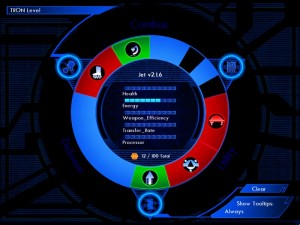 Subroutines are the most unique part of Tron 2.0 gameplay. Each of them performs a particular function. For instance, the Fuzzy Signature subroutine makes your footsteps make less noise, which is important for sneaking up on guards. Any weapons besides the primitives (such as the Suffuser and the Ball Launcher) are subroutines. There are subroutines for a wide variety of uses, like protection from virus corruption, armor upgrades, and adding corrosive damage to your weapons. You gather subroutines as the game goes on by downloading from archive bins or from enemy core dumps (the remains after they die, er, de-rez). Once you collect a subroutine, then you can always equip it, but you can’t equip everything at once. As the game goes on, you travel from one computer to another, to a PDA, to the internet, and so on. Each system has different subroutine space configurations–some have ample memory so that you can trick yourself out with a bunch of subroutines, and others have only small amounts, so you have to be very careful what you choose. Is it more important to have that body armor, or the shotgun-like Suffuser weapon? You have to make that choice.
Subroutines are the most unique part of Tron 2.0 gameplay. Each of them performs a particular function. For instance, the Fuzzy Signature subroutine makes your footsteps make less noise, which is important for sneaking up on guards. Any weapons besides the primitives (such as the Suffuser and the Ball Launcher) are subroutines. There are subroutines for a wide variety of uses, like protection from virus corruption, armor upgrades, and adding corrosive damage to your weapons. You gather subroutines as the game goes on by downloading from archive bins or from enemy core dumps (the remains after they die, er, de-rez). Once you collect a subroutine, then you can always equip it, but you can’t equip everything at once. As the game goes on, you travel from one computer to another, to a PDA, to the internet, and so on. Each system has different subroutine space configurations–some have ample memory so that you can trick yourself out with a bunch of subroutines, and others have only small amounts, so you have to be very careful what you choose. Is it more important to have that body armor, or the shotgun-like Suffuser weapon? You have to make that choice.
Here and there you will find an optimizer that you can use to upgrade just one of your subroutines. You’ll acquire most subroutines in an Alpha version, and they can be upgraded to Beta, then to Gold. The more upgraded a version, the less space it will take up in the system memory, and the more effective it will be. An Alpha routine requires three adjacent slots, while a Gold routine only requires one, and the gold version is also much better in some way or another (for instance, weapons will cause more damage, or virus protection will be more effective).
This may sound complicated, but it’s really not. The in-game tutorials are very well done, helping you learn how to play AS you play. Some of the subroutines are much more useful than others, and some are more useful against certain enemies than others. You can pause and swap in different subroutines at any time, so you can always try to pick the best ones for the current situation.
The Difficulty
I’m playing through the game again now, to get in the mood for the upcoming movie, and I’m having more trouble with it than I remember having the first time. Maybe I played the first time on Easy difficulty, this time I’m on Medium. Most of the time I can progress fine, and I try not to overuse the QuickSave function, but there are a few times when I was having difficulty and then QuickSaved in a bad place, where I was backed into a corner with low energy, surrounded by ICPs and no recent saves to fall back on. I saved in a momentarily safe place, but it was in a dead end surrounded by ICPs and I had to try to go through it a dozen times before I powered my way through using the disk weapon as efficiently as I could and zigzagging all over to make myself a hard target, and I just barely limped to the next energy source with only 3% health. After that point I tried to more meticulously make save files in a rotating fashion rather than relying on QuickSave as the primary restore method–since each QuickSave overwrites the previous QuickSave. I’m less than halfway through the game now, so we shall see how well I do when I run up against the big bad boss characters later in the game.
Light Cycles
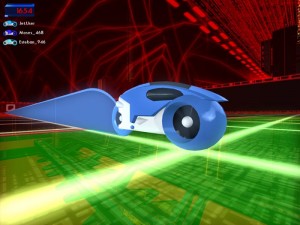 And the light cycles are back from the first game, upgraded just like everything else. In case you’re not familiar with them, they look like motorcycles, but they are incapable of stopping and they leave a solid wall wherever they pass. The objective is to be the last one standing, and you do so by outmaneuvering your opponents, placing a wall in front of them and forcing them to run into it. This upgraded version adds powerups to the mix, such as a speed boost, and a one-shot missile which can destroy enemy bikes, or punch holes through a bike-wall to allow you to pass safely through, giving it both defensive and offensive uses.
And the light cycles are back from the first game, upgraded just like everything else. In case you’re not familiar with them, they look like motorcycles, but they are incapable of stopping and they leave a solid wall wherever they pass. The objective is to be the last one standing, and you do so by outmaneuvering your opponents, placing a wall in front of them and forcing them to run into it. This upgraded version adds powerups to the mix, such as a speed boost, and a one-shot missile which can destroy enemy bikes, or punch holes through a bike-wall to allow you to pass safely through, giving it both defensive and offensive uses.
The main FPS game has some light cycle segment as part of the progression, but there’s also a light cycle tournament accessible through the main menu, with escalating difficulty levels, novelty arenas, making that a worthwhile game in itself. I hear you can also play this online, though the game is so fast-paced that the slightest lag will doom you, so it would probably be better served over a LAN.
Overall
I highly recommend this game for everyone who likes FPS, whether they are fans of Tron or not. And if you are a fan, find the game and play it to get in the mood for the upcoming movie!
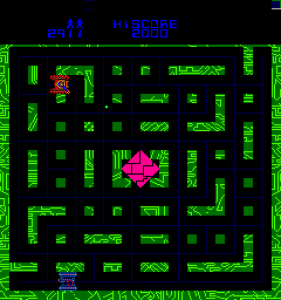 Tron (Arcade Game)
Tron (Arcade Game)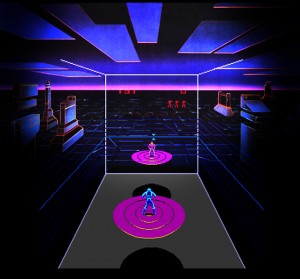 Discs of Tron
Discs of Tron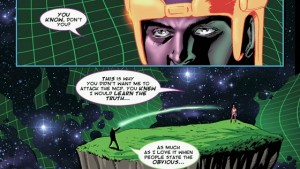 Tron:Â Ghost in the Machine
Tron:Â Ghost in the Machine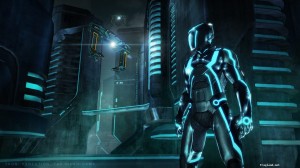 Tron:Â Evolution
Tron:Â Evolution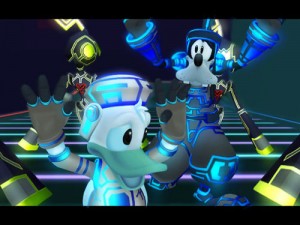 Kingdom Hearts 2 level:Â Space Paranoids
Kingdom Hearts 2 level:Â Space Paranoids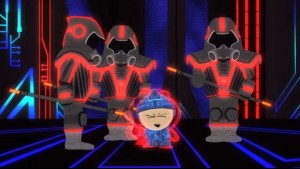 Southpark episode:Â You Have 0 Friends
Southpark episode:Â You Have 0 Friends







